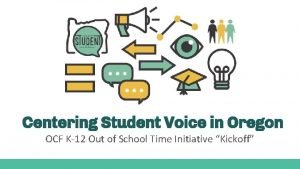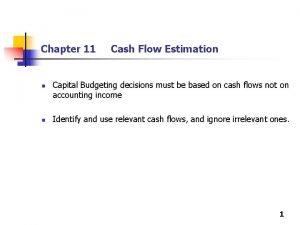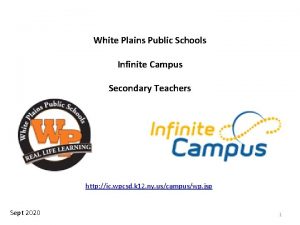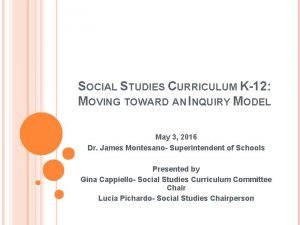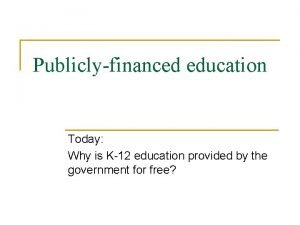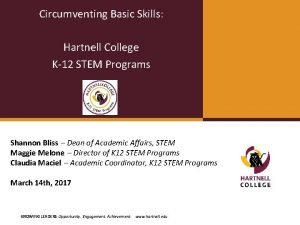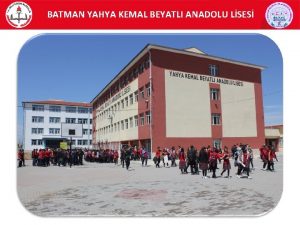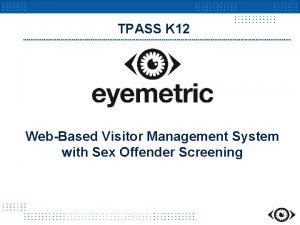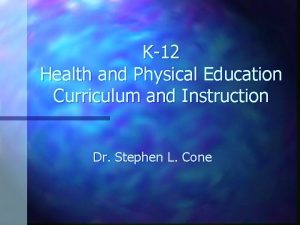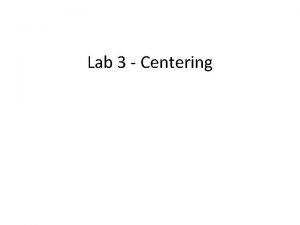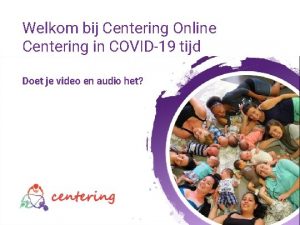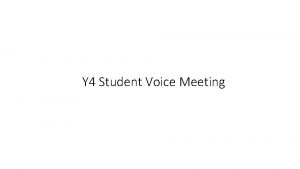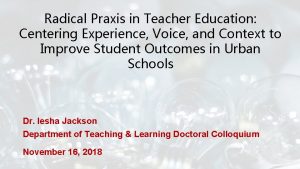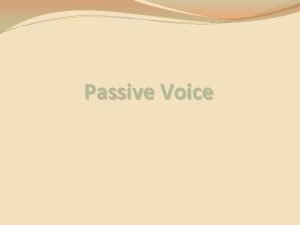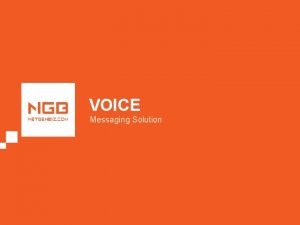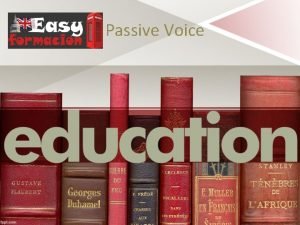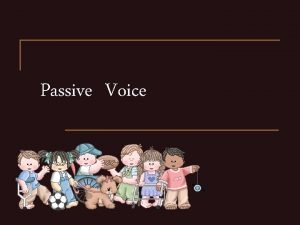Centering Student Voice in Oregon OCF K12 Out
















- Slides: 16

Centering Student Voice in Oregon OCF K-12 Out of School Time Initiative “Kickoff”

Providing Context for Student Voice

What is Student Voice? ● We define student voice as the ways in which all students have opportunities to participate in and influence the education decisions that will shape their lives and the lives of their peers (Mitra, 2009). ○ Often seen as a more democratic strategy for addressing education changes. ● We often use the term student voice interchangeable with student participation, student engagement, youth-adult partnership, etc (Murphy, 2017). ● These student voice opportunities can occur in multiple forms and levels of engagement with many different actors participating in the processes (Conner, 2015). ○ These opportunities range from participating in a survey or focus group to directly engaging in activity design.

Why is Student Voice Important? ● Research shows that students as young as 9 years old (3 rd or 4 th grade) can begin to separate themselves from adults and provide meaningful feedback on classroom instruction or program activities (Flutter & Rudduck, 2004). ● Increase youth agency, self-esteem , belonging, competence , democracy skills , and leadership (Mager and Nowak, 2012). ● Improvement in student academic achievement and health (Mager and Nowak, 2012). ● Positive changes in classroom practice and program activities to better serve student needs (Mitra & Gross, 2009).

Student Voice Models for Engagement Forms of Participation Youth run, limited influence over decisions from adults Youth run, shared decisions with adults Adult run, shared decisions with youth Adult run, active listening (etc. adults solicit & incorporate student views) Non-Participation (etc. tokenism, decoration, & manipulation) Forms of Non. Participation (Hart, 1992; Mitra & Gross, 2009; Conner, 2015)

Factors Impacting Student Engagement Identify and overcome barriers Overturn traditional adult-student roles Consider: ● Trust and openness ● Student representation ● Purpose ● Staff turnover Create: ● Shared authority ● Collective responsibility ● Inclusive environment of all abilities & contributions Solidify structures and practices Establish: ● Clear activities & goals ● Ways to complete work (collective & individual) ● Expectations (students’ first or not) Leads to a thriving student engagement (Mitra, 2004; Mitra & Holquist, 2018)

Sustainability Concerns ● l ent Growing & sustaining student voice rs e ead Research shows that there are five factors that can help grow and sustain student voice overtime (Mitra & Holquist, 2018). d Stu ● Maintain student engagement in decision making requires ongoing commitment. Flex struc ible tu prac res & tices Adult champion In s tit ut i s t pa ud ona rti en liz cip t ed at ion ed s cu Yo u -fo h t ies l l a

Discussion & Share Out ● ● For 5 minutes at your table, consider the following: ○ Is your program currently offering students opportunities to engage in decision making? ○ How is your program currently including student voice in your activities? Please prepare one example from your table to share out to the group.

Including Students in Evaluation Efforts

Why Include Students in Evaluation Efforts? ● After school programs are designed to serve the needs of students and support their development outside the classroom. ● Students often are aware of what is and what is not working for a program and can provide meaningful feedback. ● Students also provide innovative ideas that may not have been previous considered. ● Inclusion in evaluation offers another youth development opportunity and deeper learning for the students.

Ways to Include Students in Efforts ● Student Surveys: Build a survey together with your participates to ensure you are capturing the right information. ● Student-Led Focus Groups: Teach students how to lead, organize, and analyze a focus group. ● Student Observations: Show students how to observe activities, then allow them to pick an activity to observe and report on. ● Photo Voice: Co-construct photo and interview protocols with students. ● Narrative Writing: Co-construct protocols with students. ● Student Analysis: Include students in your data analysis as students often find different information than adults due to their divergent perspective.

Discussion & Share Out ● ● For 5 minutes at your table, consider the following: ○ What does your program currently due to evaluate activities? ○ How is your program including students in your evaluation efforts? Please prepare one example from your table to share out to the group.

Looking at Student Voice in Practice


How Do We Center Student Voices? ● We are a youth-led organization ; any middle or high school student attending school in Oregon can participate in program design. ● Student Surveys: Wrote a survey and administered it electronically to students across Oregon; received over 2, 200 responses. ● Student-Led Focus Groups: Designed interview protocol and conducted 13 focus groups to understand student experiences; talked to over 200 students. ● Student Reports: Conduct research, analyze data, and write reports on the student experience in Oregon’s schools; include policy recommendations for the future. ● Student Trainings: Design trainings based on the needs of our students; identified through internal and external conversations with students.

Discussion & Share Out ● ● For 5 minutes at your table, consider the following: ○ What small steps can you take right now to include student voice? ○ How can you embed student voice into your programming? Please prepare one example from your table to share out to the group.
 Oregon student voice
Oregon student voice International capital budgeting techniques
International capital budgeting techniques Change in net working capital
Change in net working capital Diphthongs classification
Diphthongs classification Song with poetic devices
Song with poetic devices Pwiveri
Pwiveri Mybill.oregonstate
Mybill.oregonstate Wpcsd.ic
Wpcsd.ic K12
K12 School vouchers pros and cons
School vouchers pros and cons K12 cart tracking
K12 cart tracking K12
K12 Val.meb.k12 batman
Val.meb.k12 batman Ero henrico k12 va us
Ero henrico k12 va us Visitor checkin software
Visitor checkin software Aleks k12
Aleks k12 K12 curriculum
K12 curriculum
